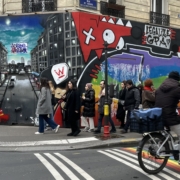Contextualizing the publication of my ROUTLEDGE HANDBOOK OF STREET CULTURE
Despite its 2021 publication date, almost four months have passed since my Routledge Handbook of Street Culture was released. Thus now is probably as a good a time as any to reflect on the goals and process connected to this project.
In you want a definition, street culture refers to “the beliefs, dispositions, ideologies, informal rules, practices, styles, symbols, and values associated with, adopted by, and engaged in by individuals and organizations that spend a disproportionate amount of time on the streets of large urban centers” (Ross, 2018, p. 8). The scholarly use of the term street culture was popularized in 1999 through Elijah Anderson’s well known book Code of the Street, and was also adopted around that time in a number of popular magazines like Juxtapoz and Hypebeast. The term included elements of popular and urban culture ranging from graffiti, street art, street crime, music, fashion (like street wear), language, etc., etc.
Why a Handbook on Street Culture Now?
Over the past decade, a proliferation of handbooks have been commissioned and published by many of the major scholarly publishers. They vary in subject matter, quality, and price.
A handbook is supposed to be foundational. It synthesizes and circumscribes the extant knowledge in a particular field. It should have the most expert people writing the chapters, and each of these contributions should review and assess all information in that narrow chunk of the field that the writer is writing about. Rarely do handbooks include chapters that are predominately empirical pieces, which are the mainstay of scholarly journals.
Handbooks are primarily released in hardcover format, and while the audience for these books, is typically other experts and graduate students, these resources are usually purchased by libraries and sold at a higher price than most other academic books. Occasionally handbooks are published as paperbacks at a cheaper price. Increasingly they are released as e-books at an even lower cost. Also many of the publishers are making individual chapters available for purchase.
So why did I edit this handbook? In short, not only did the handbook grow out personal experiences, but street culture is a dominant cross-cutting theme in most of my scholarship, including the last handbook I did, the Routledge Handbook of Graffiti and Street Art.
I edited this book because I believed that I, with the assistance of carefully selected contributors, and the subjects that they wrote on, had something unique to say, that this subject matter was not easily accessible in the popular and scholarly literature, and that this information and perspectives should be shared with a wider audience and in this type of format.
What kinds of challenges did I experience organizing a handbook on Street Culture?
Some of the challenges of editing a handbook are inherent in doing an edited book, while others are specific to a handbook, and the last is with respect to the subject matter. One of the most important hurdles are identifying and working with experts who are willing to write the chapters, under strict deadlines.
Edited books, especially handbooks are a lot of work, not just for editors like myself, but for the contributors too. From the creation of the original idea, to subject and author selection, to editing of chapters, to publication.
It often takes a long time to identify appropriate authors, follow up with them, and then shape the content of their chapter. Scholars are usually very busy. Also important is having the right balance in terms of authors and approaches to the subject matter.
Wrapping up
I hope that the Routledge Handbook of Street Culture, is useful to people who are interested in the subject, and that it will inspire others to conduct additional scholarship in the field.












